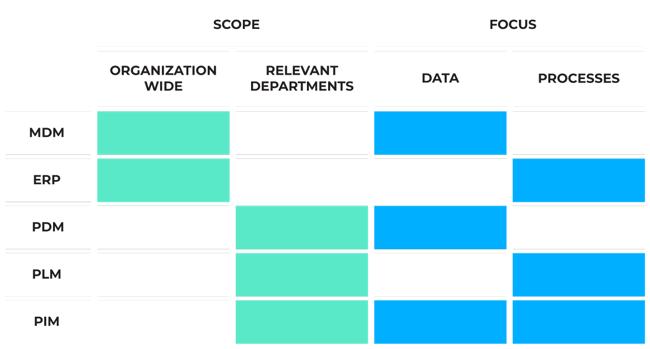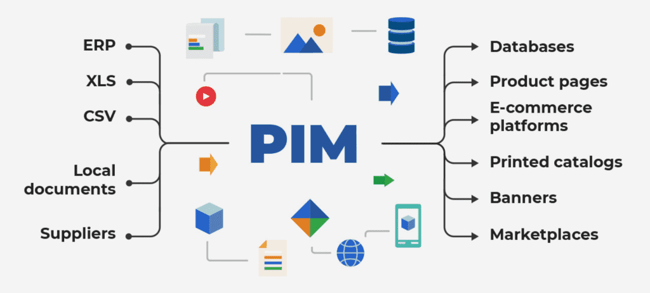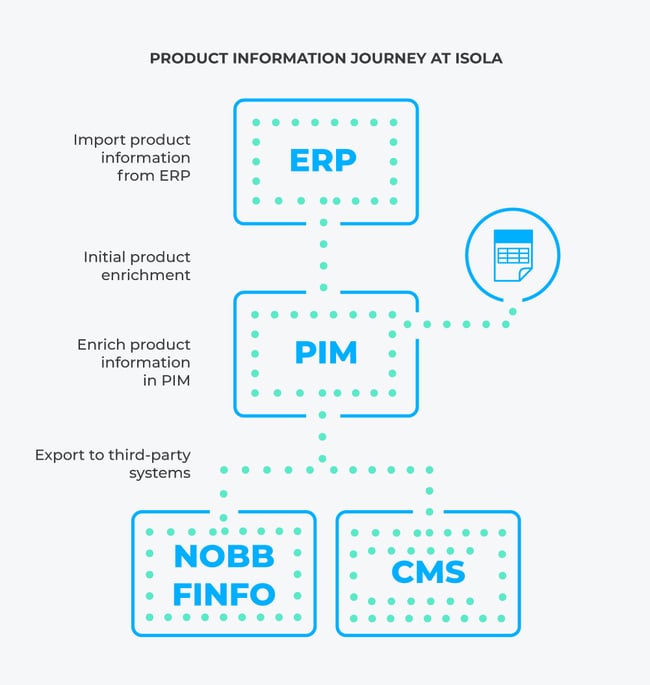The #1 Reason Manufacturers Need a PIM (besides PDM, PLM, ERP, MDM)

Table of Contents
- Facing market realities – effective product communication in a competitive climate
- What exactly is a PIM system?
- Does Sales and Marketing really need another system? They already use ERP, MDM, PDM, PLM…
- Clarifying the confusion
- PIM's key strengths and benefits for the manufacturing industry
- 5 clear indications that you need a PIM
- What specific PIM features are valuable for manufacturers?
- Case Study: Isola
- The #1 reason?
Are you looking to make your products more appealing and sell better? Do you value engaging communication with customers?
What if, despite utilizing multiple data management systems, you currently lack a crucial tool essential for achieving these objectives?
As a manufacturer, you probably use various systems to handle a large amount of data crucial to your operations. The manufacturing process is complex, so it needs reliable data management solutions that help with various tasks across your organization, like research and development (R&D), supply chain management, quality assurance, and others.
While common solutions like Enterprise Resource Planning (ERP), Master Data Management (MDM), and Product Data Management (PDM) or Product Lifecycle Management (PLM) excel at enhancing internal data management and operations, some manufacturers miss the importance of specialized software for gaining a competitive edge in external, sales and marketing communication.
Facing Market Realities – Effective Product Communication in a Competitive Climate
The reality that manufacturers must confront is that in today's highly competitive market, effectively presenting the value and features of products is crucial for standing out.
Ignoring market communication aspects while narrowly focusing on production and assuming that a good product with a basic description or specification is sufficient for marketing could severely disadvantage them.
Relying on distributors, resellers, and online stores to handle product information enrichment poses the risk of presenting your products in a generic, uninteresting, or even inconsistent and misleading manner.
Customers seek comprehensive, unified, and engaging experiences with rich product information that persuades them your products are the right fit for their expectations. Therefore, to be successful, manufacturers need to ensure that not only their R&D and Manufacturing departments are equipped with excellent software but also their Sales and Marketing teams.
This is where Product Information Management (PIM) systems come into play.
What exactly is a PIM system?
A PIM system is specialized software that enables companies to establish a centralized repository for all product-related data, facilitating management, enrichment, collaboration, and data syndication across sales and marketing channels.
This centralized approach streamlines processes, enhances data accuracy, and empowers sales and marketing teams with rich, consistent product information to drive customer engagement and conversions.
Does Sales and Marketing Really Need Another System? They Already Use ERP, MDM, PDM, PLM, etc.
There are questions that might be looming in many minds: "Do we really need to invest in another data management system, like PIM?" and "Maybe our current solutions can handle the task, since our Sales and Marketing Team already uses an ERP and PLM?”.
Or perhaps the most important question is, “Can a PIM system bring considerable business value to our company?"
The answer lies in understanding the unique value proposition of PIM and its potential to drive significant business outcomes. While it's true that other systems may centralize product data or manage it to some extent, PIM systems offer distinct functionalities tailored specifically for comprehensive product information management to be syndicated to business partners, distributors, resellers and customer-facing channels.
Clarifying the confusion
Let's dispel any uncertainty surrounding the most popular data management systems and explore how PIM distinguishes itself and can enhance your existing setup.
While these solutions may share some similarities, it's crucial to emphasize their focuses and strengths for clarity.
MDM and ERP
MDM = organization-wide central repository for master data
Beginning with MDM, it serves as the central repository for your organization's critical operational and decision-making data, such as HR data, payroll, invoicing, customer data, and product data. The goal is to create a single source of truth accessible across departments.
MDM's greatest strength lies in its comprehensiveness and its ability to centralize data, enhancing internal business operations by covering a wide range of data and management needs across departments.
-
Typical users:
-
Entire organization - various departments
-
-
Example uses:
-
HR
-
Employee payroll
-
Customer details
-
Invoicing
-
ERP = organization-wide integrated system managing core business processes
ERP systems excel at facilitating processes, especially those related to finances, HR, supply chain, inventory, and customer relationship management.
They focus on automating workflows, sharing data, and also serving as a data repository. Consequently, they are also proficient at utilizing master data centralized in an MDM system, enabling the organization to streamline day-to-day operations.
-
Typical users:
-
Entire organization - various departments
-
-
Example uses:
-
Inventory
-
Raw product data
-
Supply chain
-
Procurement
-
However, MDM and ERP are not specialized in sales and marketing. On one hand, they offer numerous features and functions unrelated to product marketing. On the other hand, they lack specialized PIM functions that could enhance effectiveness in the market, such as data enrichment or optimization tailored to the requirements of various channels.
Now, let's turn our attention to systems more focused on managing products and product related data.
PDM and PLM
PDM = repository for data and documentation related to products, design and manufacturing
PDM specializes in establishing a central repository for files and documentation related to product design, engineering, and manufacturing. In contrast to PLM, it has a narrower focus, concentrating on managing data related to product development processes.
-
Typical users:
-
Design and Engineering
-
Manufacturing
-
Documentation departments
-
-
Example uses:
-
Managing CAD files and revisions
-
BOM - creating and maintaining bills of materials
-
ECOs - tracking engineering change orders
-
Design documents and specifications
-
PLM = managing product lifecycle
PLM streamlines and optimizes the processes and information associated with product development, manufacturing, and delivery throughout the product lifecycle. It takes a comprehensive approach that aims to improve collaboration, version control, and compliance at all stages of product development and production.
-
Typical users:
-
Various departments – mainly Designers, Engineers, also Manufacturing, Supply Chain, Quality, Sales and Marketing
-
-
Example uses:
-
Design collaboration
-
Lifecycle analysis
-
Managing CAD and other relevant files, documents, and presentations
-
Managing BOMs and ECOs
-
PLM and PDM are not specifically designed for marketing and communication tasks, however, sales and marketing departments can still find value in these systems. They can also contribute data and insights to PLM from their market analysis or customer feedback.
PLMs lack functionalities essential for effective marketing and communication strategies, such as managing multi-channel content distribution, optimizing digital assets for different channels, and facilitating localization and translations.
Snapshot overview
- While MDM focuses on managing data across the enterprise, ERP streamlines processes across the enterprise.
- PDM systems narrow their focus to product data, particularly in relation to design and manufacturing, whereas PLM oversees both products and processes throughout the product lifecycle.
- Each system plays a distinct but vital role in ensuring efficiency and coherence within organizational operations.

PIM's Key Strengths and Benefits for the Manufacturing Industry
PIM = rich product content for sales and marketing channels
Purpose of PIM Implementation
The goal of implementing PIM is to establish a centralized repository for enriched product information and relevant digital assets, ensuring that information remains up-to-date and synchronized across all sales and marketing channels.
-
Typical users:
-
Sales & Marketing
-
E-commerce
-
-
Example uses:
-
Product data syndication and synchronization
-
Managing SKUs/Product catalog
-
Managing product offers - bundling, configuration, cross-sell
-
Content optimization and omnichannel distribution
- Data enrichment, customization and localization
-
Understanding PIM's role in your technology stack
When assessing how PIM can fit into your technology stack, it's crucial to understand its distinct role.
Unlike other systems primarily focused on internal data and process management, PIM prioritizes external data orientation and distribution. Specifically designed for managing information intended for publishing to distributors and end customers, PIM centralizes this data, serving as a single source of truth for product information across various external channels. This facilitates efficient collaboration, data enrichment, and content optimization processes.
While other systems do provide product data, such as specifications, documentation, and manuals, these raw data points alone may not effectively capture attention in today's competitive market landscape.
Adding to the challenge, typical all-in-one solutions like ERP and MDM from major vendors aim to address a broad range of needs, offering rudimentary and limited capabilities for some major platforms and channels. However, this restrictive approach can severely constrain your ability to syndicate product data efficiently, often resulting in a reliance on error-prone and time-consuming spreadsheet data exchange.
Consider a scenario with a sophisticated Composable Commerce-ready PIM solution. Equipped with numerous APIs, it not only caters to your current channels and systems but also prepares you to connect and publish data to new sales channels or systems should you identify new opportunities or partners. This market agility empowers your manufacturing company to respond swiftly, expanding its presence to more places with compelling content.
Therefore, integrating PIM enables your manufacturing company to ensure that your product information is accurate, comprehensive, and optimized for maximum impact in capturing consumer interest and engagement.
This encompasses various platforms such as marketplaces, reseller landing pages, product catalogs, social media, and more.

5 Clear Indications That You Need a PIM
Here are 5 key indicators your manufacturing company can strongly benefit from implementing a PIM:
-
Your product data for sales and marketing is fragmented across multiple platforms, files, and sources, resulting in challenging and inefficient management processes.
-
Your marketing team is burdened by working with systems with numerous features and excessive data unrelated to their tasks and goals, hindering productivity.
-
You distribute data to numerous sales channels, distributors, wholesalers, marketplaces, and both online and brick-and-mortar stores, leading to complexity and potential inconsistencies.
-
You find yourself repeatedly updating the same product information in multiple platforms, and systems, wasting valuable time and resources.
-
Your company has an international or global presence, requiring the efficient distribution of accurate and comprehensive product data to company branches and geographical locations. This includes addressing localization and translation needs, such as language variations, units of measure, compliance documentation, certifications, manuals, catalogs, and more.
What Specific PIM Features Are Valuable for Manufacturers?
PIM systems offer numerous features and functionalities that can benefit manufacturing companies by enhancing data centralization and streamlining processes related to product information management.
Data Centralization
-
One centralized platform to conveniently connect and manage product data along with all relevant digital assets, enabling the creation of coherent, rich content for sales and marketing purposes.
-
Data exchange capabilities to reliably exchange data using spreadsheets and other files
-
Connect your data precisely where it's needed via ready integrations and API connectivity, especially with composable, MACH-based PIM solutions that allow for extensive data synchronization, even with headless systems like headless DAM or CMS.
-
Easily publish and synchronize product information across various systems and channels with just a few clicks.
Streamlining Processes
-
Eliminate repetitive and manual tasks with automated or semi-automated synchronization to update and unify data across channels. Utilize smart import-export features and mapping templates to accelerate data exchange. Use AI features to quickly enrich, correct or translate your product information in bulk
-
Organize work, manage tasks, and communicate with all individuals involved in product information management within a single collaboration environment and in the immediate context of relevant products.
-
Generate product sheets in bulk aligned with corporate identity and branding guidelines using custom templates. Streamline catalog creation with Adobe InDesign integration to feed product information into the application.
Those examples illustrate some of the ways PIM features can benefit your company. However, with a composable PIM like Bluestone PIM, you can take your product information management to unprecedented levels of efficiency, automation, and integration.
By designing a composable solution perfectly tailored to the needs of your manufacturing company, you can achieve optimal performance and effectiveness.
Case Study: Isola
Isola manufactures high-quality solutions for roofs, walls, floors, and foundations, dominating the Norwegian market and expanding across Europe.
The Challenge
Facing a challenge without a centralized data repository, Isola stored basic product data in the ERP system and scattered additional details across spreadsheets. This fragmented setup hindered internal sharing, especially among branch offices.
Acknowledging the need for seamless data flow, Isola aimed to integrate comprehensive product data into external systems.
The Solution
Isola chose Bluestone PIM to establish a central source of truth for product information. By leveraging their ERP data and importing additional information from spreadsheets, Isola can efficiently enrich and prepare product information for distribution to sales and marketing channels, including CMS and various third-party platforms like the NOBB industry database, all within one collaborative environment.
Furthermore, Isola successfully eliminated many manual tasks related to updating product information, a capability that was not achievable before implementing Bluestone PIM.

The Results
This ensures that business partners, distributors, and customers receive enriched and up-to-date product information.
Additionally, thanks to Bluestone PIM's extensive API capabilities and numerous ready integrations, Isola has the option to integrate with more systems, platforms, and channels if needed, allowing them to import and distribute their enriched product information to even more places.
The #1 reason?
In a nutshell, the number one reason why a manufacturer needs a PIM system is to gain an edge in today's competitive markets.
To effectively empower your sales and marketing teams, you need a specialized tool designed specifically for managing product information across customer-facing channels and distributors — namely, a PIM system. Relying solely on generic, enterprise-wide solutions such as an ERP or MDM system, or those more focused on manufacturing and product development like PLM and PDM, for these crucial tasks can lead to inefficiencies, missed opportunities, unnecessary costs, repetitive tasks, and errors.
If you aim to expand your market presence and deliver outstanding product content that captures the market's attention, then a PIM system can provide you with a specialized solution worth serious consideration.
Curious to discover more about Bluestone PIM and its potential to take your manufacturing business's product information management to new heights? Schedule a free consultation with our PIM advisors or reserve a demo to see Bluestone PIM in action.




